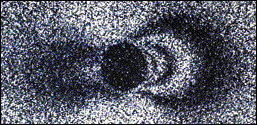Daniel C. McCarthy, News Editor
Stress is part of the job for John Deere products built by Deere & Co., which manufactures equipment for agricultural, industrial and forestry applications as well as for home and garden. Before this equipment is even assembled, the component metal parts accumulate residual stress during the manufacturing process. Deere is developing a system that detects residual stress in metal components using TCC-2 holographic cameras built by Tavex America Inc.

Deere & Co. is using Tavex's TCC-2 holographic camera to detect residual stress -- appearing as interference fringes -- released at holes drilled into their manufactured parts. Courtesy of Deere & Co.
"Stress is inherent in the processing of a part. Castings are cast," said Susan Foss, a senior engineer at Deere, "and later, cooling and machining processes all put further stress on the part." A design may specify that a part needs to support 500 mega-Pascals (MPa), she said. But the working of the raw material may produce 450 MPa within the finished part, which means the part can support only 50 MPa more of outside stress.
The system Foss is developing requires a hole to be drilled into the metal part, causing localized release of residual stress. When viewed through the holographic plate in Tavex's camera, the released stress appears as interference light fringes. Foss pointed out that the analysis qualifies as nondestructive for many parts because the drilled holes are often less than 1/32 in. in diameter.
Previous stress analysis relied on x-ray diffraction, strain gauge hole drilling or strain gauge cutting techniques that were costly, time-consuming and, in the case of the latter technique, extremely destructive to the part. Foss selected Tavex's shoe-box-size camera over competitive holographic devices that were eight times larger, but cost and analytical speed were also factors. Tavex's camera provides results in one to two seconds as compared with hours for other systems.
Further, the system need not be isolated or limited to an optical bench, because its size and stability allow it to be moved around and used on the assembly and manufacturing floor. The camera is not used in-line for part-by-part analysis, but Foss hopes it will be someday.
The TCC-2 camera's 40-mm2 holographic plate is made from a photopolymer developed in Ukraine and refined in the US by Tavex America. According to George Zahaykevich, president of Tavex, more than 3000 holograms may be created, stored and erased before the plate needs to be replaced.